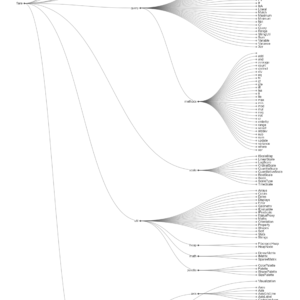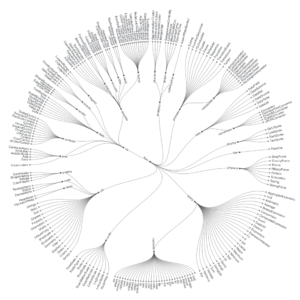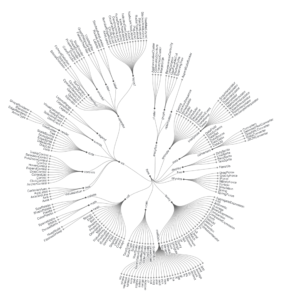Description
A phylogenetic tree, also known as an evolutionary tree or cladogram, is a branching diagram that illustrates the evolutionary relationships between different species or groups of organisms. It represents the hypothesized evolutionary history or ancestry of these organisms, with branches representing ancestral lineages and nodes representing common ancestors. The length and arrangement of branches in the tree reflect the degree of genetic divergence between species, with closely related species sharing more recent common ancestors and longer branches indicating greater genetic distance. Phylogenetic trees are constructed based on molecular data, morphological traits, or a combination of both, using various algorithms and statistical methods to infer evolutionary relationships. These trees provide valuable insights into the evolutionary processes that have shaped biodiversity and species divergence over time.
Uses:
- Evolutionary History Reconstruction: Phylogenetic trees are used to reconstruct the evolutionary history of organisms, revealing patterns of speciation, extinction, and diversification.
- Taxonomic Classification: They aid in taxonomic classification by grouping species into clades based on shared evolutionary ancestry, helping to define higher taxonomic ranks and relationships.
- Biogeographic Analysis: Phylogenetic trees help study the geographic distribution of species and understand how evolutionary processes and historical events have shaped biogeographic patterns.
- Disease Transmission Analysis: They are used to track the transmission and spread of infectious diseases by analyzing the genetic relatedness of pathogen strains and identifying common ancestors.
- Phylogenetic Comparative Methods: Phylogenetic trees are employed in comparative biology to study trait evolution, adaptation, and ecological relationships across different lineages.
- Conservation Planning: They inform conservation planning and management strategies by identifying evolutionarily distinct and genetically diverse species or populations for prioritized conservation efforts.
- Crop Improvement: Phylogenetic trees help trace the evolutionary relationships between crop species and their wild relatives, facilitating the identification of genetic resources for crop improvement.
- Forensic Analysis: They aid in forensic analysis by reconstructing the evolutionary relationships between DNA sequences and identifying genetic markers for forensic identification purposes.
- Drug Discovery: Phylogenetic trees are used in drug discovery and natural product research to identify bioactive compounds from phylogenetically related organisms and predict their biological activities.
- Ecological Community Assembly: They help study ecological community assembly processes by examining the phylogenetic structure of species assemblages and inferring community assembly mechanisms.
Purposes:
- Hypothesis Testing: Testing evolutionary hypotheses and theories by comparing alternative phylogenetic tree topologies and evaluating their fit to the available data.
- Biological Inference: Inferring biological characteristics, traits, and behaviors of ancestral species based on their placement in the phylogenetic tree and patterns of character evolution.
- Historical Biogeography: Reconstructing historical biogeographic events, such as continental drift, dispersal, and vicariance, by analyzing the geographic distribution of taxa in the phylogenetic tree.
- Molecular Clock Calibration: Estimating the timing of evolutionary events and divergence times between lineages using molecular clock methods applied to phylogenetic trees.
- Community Ecology: Exploring patterns of phylogenetic diversity and relatedness within ecological communities to understand community assembly processes and ecosystem functioning.
- Comparative Genomics: Identifying genomic regions under positive selection, gene family expansions, and functional innovations by comparing genomes across different branches of the phylogenetic tree.
- Phylogenetic Medicine: Studying the evolutionary origins of diseases, host-pathogen interactions, and immune responses to inform medical research and public health interventions.
- Phylogenetic Signal: Assessing the strength and consistency of phylogenetic signal in morphological, behavioral, or ecological traits to understand trait evolution and phylogenetic inertia.
- Species Delimitation: Delimiting species boundaries and defining species concepts based on patterns of genetic divergence and evolutionary independence inferred from phylogenetic trees.
- Evolutionary Conservation: Identifying evolutionarily distinct and globally endangered species for conservation prioritization and biodiversity conservation planning efforts.
Only logged in customers who have purchased this product may leave a review.






Reviews
There are no reviews yet.